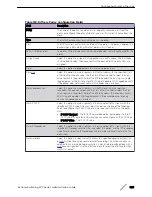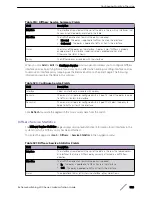
2 Configure ports 1/0/1, 1/0/2 as members of VLAN 10 and specify that untagged frames received on
these ports will be assigned to VLAN 10.
config
interface1/0/1
vlan participation include 10
vlan pvid 10
exit
interface1/0/2
vlan participation include 10
vlan pvid 10
exit
3 Configure port 1/0/3 as a member of VLAN 20 and specify that untagged frames received on these
ports will be assigned to VLAN 20
interface1/0/3
vlan participation include 20
vlan pvid 20
exit
exit
4 Specify that all frames transmitted for VLANs 10 and 20 will be tagged.
config
vlan port tagging all 10
vlan port tagging all 20
exit
5 Enable routing for the VLANs:
(Extreme 220) (Routing) #vlan database
vlan routing 10
vlan routing 20
exit
6 View the logical interface IDs assigned to the VLAN routing interfaces.
(Extreme 220) (Routing) #show ip vlan
MAC Address used by Routing VLANs: 00:00:AA:12:65:12
Logical
VLAN ID Interface IP Address Subnet Mask
------- -------------- --------------- ---------------
10 0/4/1 0.0.0.0 0.0.0.0
20 0/4/2 0.0.0.0 0.0.0.0
As the output shows, VLAN 10 is assigned ID 0/4/1 and VLAN 20 is assigned ID 0/4/2
7 Enable routing for the switch:
config
ip routing
exit
8 Configure the IP addresses and subnet masks for the virtual router ports.
config
interface 0/4/1
ip address 192.150.3.1 255.255.255.0
exit
interface 0/4/2
ip address 192.150.4.1 255.255.255.0
exit
exit
Using SNMP to Configure VLAN Routing
While setting the IP address for the VLAN interface, the agentSwitchIpInterfaceIpAddress and
agentSwitchIpInterfaceNetMask should be set together.
Configuration Examples
ExtremeSwitching 200 Series: Administration Guide
339















































